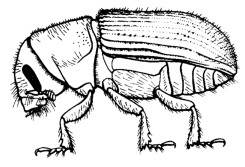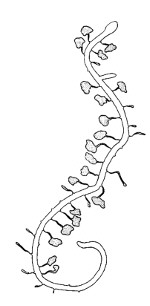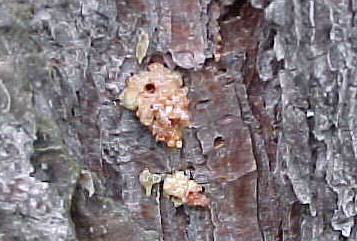Southern Pine Beetle
ENTFACT-443: Southern Pine Beetle | Download PDF
by Lee Townsend, Extension Entomologist & Lynne Rieske-Kinney, Research Entomologist
University of Kentucky College of Agriculture

Southern Pine Beetle
The southern pine beetle (SPB) is the most destructive forest insect in the southern US, and can also cause damage in urban settings. Outbreaks last 3 to 4 years, and in Kentucky occur at approximately 25- to 30-year intervals because we are at the northern extreme of the SPB's geographical range. Mild winters and drought may have set the stage for the temporary explosion that has occurred recently in the Commonwealth.
Life Cycle
Southern pine beetles are 1/8 inch long and have cylindrical, reddish-brown to black bodies. There are several overlapping generations in Kentucky each year. All stages of the life cycle (egg, larva, pupa, and adult) can be found in trees at any time. Development is faster in the summer (26 days) than during the winter (54 days). Following a period of relative inactivity in the winter, adults begin to fly again in the spring.

SPB Galleries
Females land 6 to 30 feet above the ground on mature trees and bore into the bark. There, they create galleries in which they mate and lay eggs. The yellowish white, legless grubs feed in the inner bark, enlarging their tunnels as they grow. Mature larvae move to the outer bark and create a cell in which they pupate. New adults chew through the bark, leaving small, clearly visible, open exit holes. Adult emergence may continue for an extended period of time. Generally, they leave the host tree and aggregate on a nearby tree; however, some may fly several miles before attacking a new tree. When adults successfully attack a new host tree, they produce a pheromone or chemical scent that attracts other males and females. Within a few days, thousands of beetles may attack a tree and overwhelm its defenses. Excess beetles land on and colonize nearby trees, creating "hot spots," and the infestation expands.

Trees killed by SPB in Red River Gorge, KY
Infestations
Southern pine beetle infestations are characterized by trees with reddish brown crowns surrounded by those with green needles. Obvious signs of infestation include white pitch tubes, running pitch, sawdust at the base of the tree, and many small emergence holes in the bark.
Larvae chew curved or S-shaped galleries under the bark in the inner bark and cambium layer, and can girdle and kill the tree. In addition, the beetles introduce a fungus that can be lethal to the tree. Other species of bark beetles can be present in the same tree but their larvae produce I-, Y-, or H-shaped galleries (See Entfact 437, Borers That Attack Landscape Pines).
Southern pine beetles prefer shortleaf, loblolly, Virginia, and pitch pines. The beetles usually are attracted to weakened mature trees, those more than 15 years old and with a trunk diameter of less than 6 inches.

Southern Pine Beetle Exit Hole
During outbreaks, they attack trees that appear to be healthy and vigorous. Infestations usually begin on the mid-trunk area and then expand up and down the length of the tree. Resistant species such as slash, longleaf, and eastern white pine, have a high resin exudate that provides an effective defensive mechanism against the beetle.
However, even resistant trees can be attacked successfully when the beetles are very abundant.
Management of Infestations
Southern pine beetles often attack stressed and injured trees in older-aged, dense stands, so cultural practices that promote healthy trees will reduce the frequency and severity of infestations. During outbreaks, avoid pruning and other activities which produce odors that attract dispersing beetles.
An insecticide may be sprayed onto the trunk of landscape pines to protect them when there is an active SPB infestation in the area. Astro (permethrin) is labeled for bark beetle control. The insecticide should be applied on dry bark to the point of runoff, from the base of the crown down to the ground. This is a preventive approach only, since the insecticide will not penetrate the bark and kill life stages that are already in an infested tree. Several applications (spring, mid summer, and late summer) may be necessary because of the long activity period of the adults. When carefully and properly applied, these insecticides dry in a few hours and pose little danger to birds, squirrels, or humans.
Since SPB attack mature trees, spray coverage and potential applicator exposure can be a problem. Relatively high pressure, provided by specialized equipment, may be needed to spray the trunk to an adequate height. Consider using a certified commercial applicator.
Southern pine beetles have natural enemies that can have a significant impact on their mortality over a wide area, but will probably not provide satisfactory protection of individual or small numbers of trees in a landscape setting.
Short Term Strategy
- Identify the problem. There are several species of bark beetles that attack stressed pines. Usually only the SPB poses a threat to tree survival.
- Remove and destroy severely infested trees. They are unlikely to survive and will serve as a source of beetles to attack nearby trees.
- Use preventive sprays to protect nearby susceptible trees. Outbreaks in Kentucky are rare and short-lived. It is unlikely that a long term spray program will be needed.
Long Term Strategy
- Promote tree health by proper watering and fertilization.
- Select sites for new plantings carefully to avoid tree stress later.
Issued: 9/00
Revised: 7/19
CAUTION! Pesticide recommendations in this publication are registered for use in Kentucky, USA ONLY! The use of some products may not be legal in your state or country. Please check with your local county agent or regulatory official before using any pesticide mentioned in this publication.
Of course, ALWAYS READ AND FOLLOW LABEL DIRECTIONS FOR SAFE USE OF ANY PESTICIDE!
Photos: Lee Townsend, University of Kentucky Entomology. B&W images: US Forest Service
